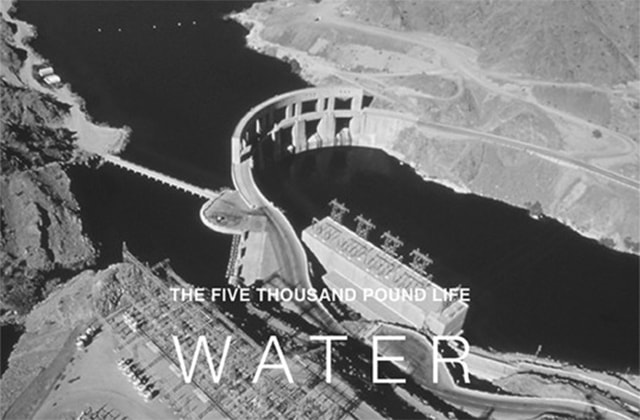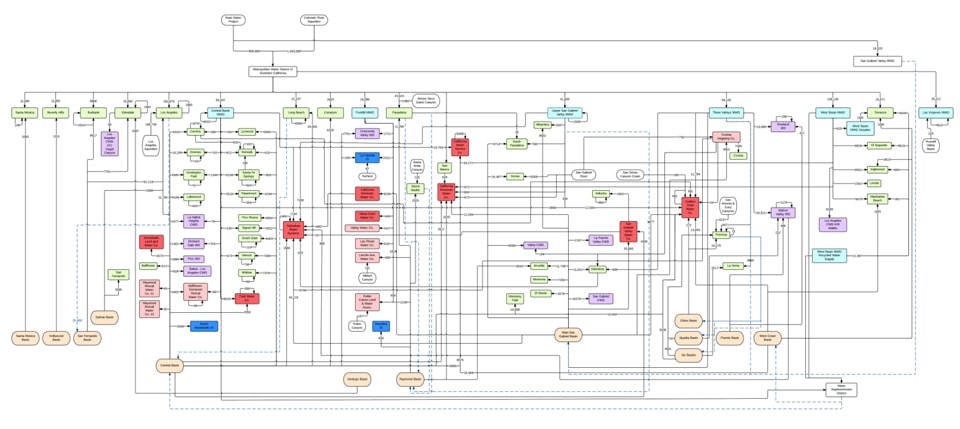Photo by Charles O’Rear, desaturated from original.
February 7th marked the most recent event in the ongoing Five Thousand Pound Life series, The Architecture League of New York’s multi-year initiative of public events, digital releases, and design studies that look at the challenges of reimagining the American way of life to address climate change.
This is the third in the series of 5KL symposia, which so far have tackled Energy, Land, and now Water. Both focused and expansive, the Water symposium cast its net across three very different regions, each with its own water worries—Los Angeles, the Great Lakes, and New York. All three regions have rich histories enabled by daring feats of civil engineering. Aqueducts, reservoirs and thousands of miles of canals and pipes have allowed cities and regions to grow, but have also irrevocably altered natural hydrological patterns. Today, each region is struggling to manage these legacy infrastructures and adapt them to the challenges of the coming century.
New York City is well supplied with drinking water because of the visionary and technically pioneering work of local leaders and civil engineers in the 19th century, who gave civic identity to the city’s water infrastructure system. Now we have moved from a century of engineering to a century of management. As Al Appleton, the former director of the city’s Department of Environmental Protection made clear in his talk, intelligently managing the old pipes and dams, the watershed lands, the sewage treatment, and waste disposal operations of this massive system is no easy task, although it is absolutely critical. Helping farmers fence pastures and control their waste flows in the vast Upstate watershed of the aqueduct system helps water quality downstream, saving billions over the new water filtration plants that would otherwise be needed. Reducing water use and runoff reduces wastewater treatment demands, which saves energy and waste disposal costs, freeing up money to staff up wastewater treatment plants so that they run more efficiently. Decision pathways are interconnected, and getting consensus from farmers, administrators, regulators, environmentalists and economists is a management task that lets New York’s historic and heroic public works continue to function. The upcoming challenges will revolve around retrofits for coastal protection and ongoing operation—such as what to do with billion-dollar low-lying wastewater treatment plants, and a sewer system designed with outfalls that will be underwater if this century’s expected sea level rise exceeds their 3.5-foot elevation above mean high tide.
The Great Lakes are grappling with their own challenges of how to manage water quality in an enormous transnational watershed that incorporates 8 states, a province and 40 tribal governments—a region so large that it makes its own weather, but whose stability is threatened by invasive species, urban and industrial effluents, and climate-driven changes to the precipitation patterns beyond the design criteria for current infrastructure. Here too, hydrology has been altered by great feats of civil engineering. The watersheds of the Great Lakes are now connected to the larger Mississippi River thanks to the historic reversal of the Chicago River in 1900; cities like Chicago have spent incredible sums of money on deep tunnels and reservoirs to comply with water quality regulations for the water that enters the Great Lakes and the river. Poorer cities like Detroit with legacy water and wastewater infrastructure that they can’t afford are experimenting with green infrastructure strategies for urban runoff, but are a long way from either compliance or a coherent civic identity for this new soft infrastructure.
A visualization of the complex flows of potable water in L.A. County, as developed by the CCSC at UCLA, 2014.
But it was Los Angles that stole the show, with the most dramatic example of the overlaps between the infrastructure of water, energy, food, and urbanization. Whereas heroic acts of civil engineering had historically enabled a metropolis to grow in the middle of a desert, the water supply is not only on the brink of collapse from dramatic decreases in snowpack that feeds the reservoirs, but is constantly stymied by a fragmented jurisdictional and ownership landscape that makes holistic water management next to impossible. Stephanie Pincetl from UCLA’s California Center of Sustainable Communities presented a dizzying visualization of the complex system of water governance in L.A. County, where water rates are set by over 100 water retailers, in 5 municipal water districts, across 4 basins overseen by 7 watermasters. Despite a four-year drought and shrinking snowpack that point to a very dry future for California, Pincetl suggests that L.A. doesn’t have a crisis of water, but rather a crisis of water management. Meanwhile, using an approach that blended political ecology and industrial ecology, Joshua Newell presented a powerful Life Cycle Analysis of the L.A. water system’s energy use, which exposes dramatic differences in energy consumption between the four aqueducts that supply the city. Local groundwater and recycled water don’t come out blameless on the energy use side, and surprisingly it is the LA Aqueduct that stole the water from Owens Valley that comes out on top as least energy-intensive to operate.
These diverse examples all point to a sense that biophysical, cultural and political landscapes are deeply intertwined. Understanding complex infrastructural systems requires thinking across both distance and disciplines. We need to foster collaboration between researchers from engineering, environmental science, economics, design and management both to model complex system performance, and to visualize the impact of these interventions. Effective communication will build a water-savvy public better informed and empowered to make responsible decisions in daily life that have far-reaching environmental impacts. Water management is a challenge of representation, communication, and imagination, and is as urgent today as in the days of thirst and cholera.

